brakes YAMAHA TW125 2000 Owners Manual
[x] Cancel search | Manufacturer: YAMAHA, Model Year: 2000, Model line: TW125, Model: YAMAHA TW125 2000Pages: 86, PDF Size: 3.94 MB
Page 50 of 86
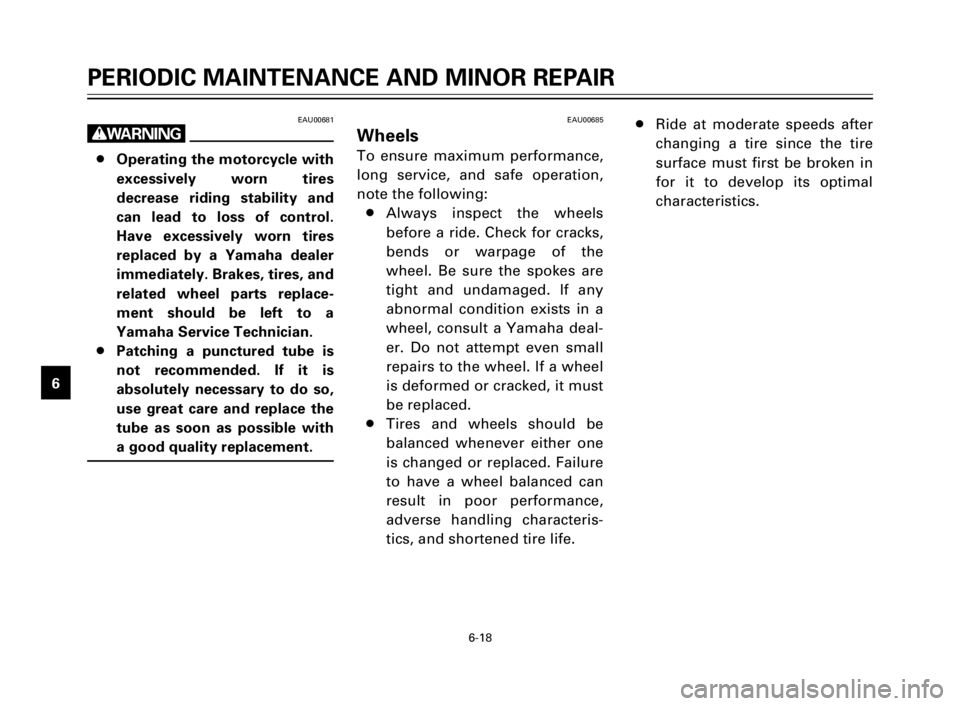
6-18
PERIODIC MAINTENANCE AND MINOR REPAIR
1
2
3
4
5
6
7
8
9
EAU00681
w
8Operating the motorcycle with
excessively worn tires
decrease riding stability and
can lead to loss of control.
Have excessively worn tires
replaced by a Yamaha dealer
immediately. Brakes, tires, and
related wheel parts replace-
ment should be left to a
Yamaha Service Technician.
8Patching a punctured tube is
not recommended. If it is
absolutely necessary to do so,
use great care and replace the
tube as soon as possible with
a good quality replacement.
EAU00685
Wheels
To ensure maximum performance,
long service, and safe operation,
note the following:
8Always inspect the wheels
before a ride. Check for cracks,
bends or warpage of the
wheel. Be sure the spokes are
tight and undamaged. If any
abnormal condition exists in a
wheel, consult a Yamaha deal-
er. Do not attempt even small
repairs to the wheel. If a wheel
is deformed or cracked, it must
be replaced.
8Tires and wheels should be
balanced whenever either one
is changed or replaced. Failure
to have a wheel balanced can
result in poor performance,
adverse handling characteris-
tics, and shortened tire life.8Ride at moderate speeds after
changing a tire since the tire
surface must first be broken in
for it to develop its optimal
characteristics.
5EK-9-E1 (TW125)<3.1> 4/6/0 11:50 PM Page 48
Page 54 of 86
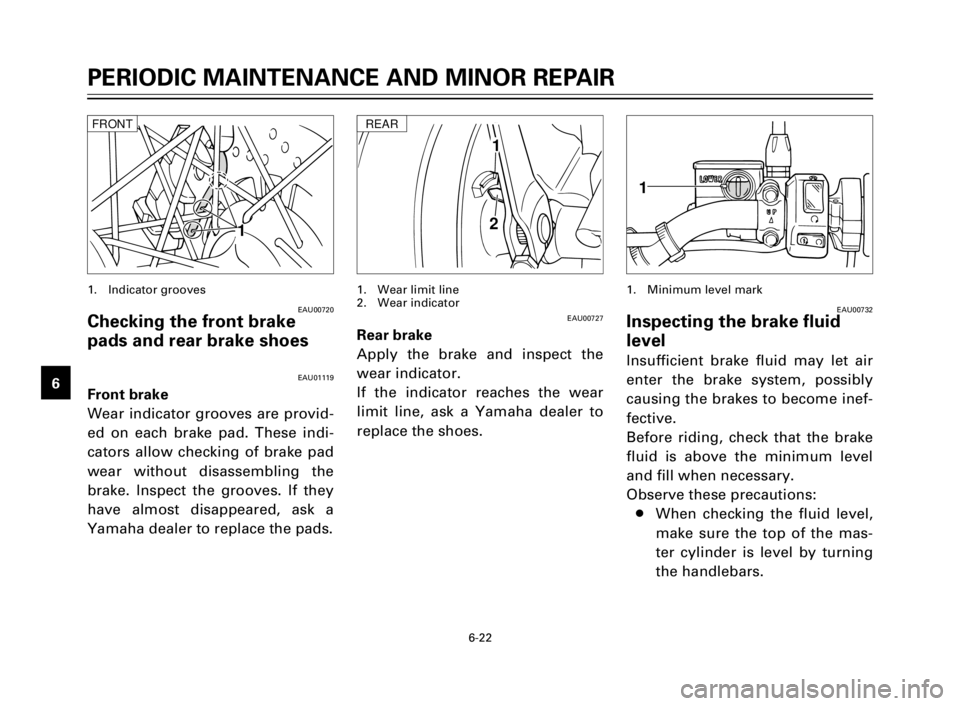
6-22
PERIODIC MAINTENANCE AND MINOR REPAIR
1
2
3
4
5
6
7
8
9
EAU00720Checking the front brake
pads and rear brake shoes
EAU01119
Front brake
Wear indicator grooves are provid-
ed on each brake pad. These indi-
cators allow checking of brake pad
wear without disassembling the
brake. Inspect the grooves. If they
have almost disappeared, ask a
Yamaha dealer to replace the pads.
1. Indicator grooves
EAU00727
Rear brake
Apply the brake and inspect the
wear indicator.
If the indicator reaches the wear
limit line, ask a Yamaha dealer to
replace the shoes.
1. Wear limit line
2. Wear indicator
EAU00732Inspecting the brake fluid
level
Insufficient brake fluid may let air
enter the brake system, possibly
causing the brakes to become inef-
fective.
Before riding, check that the brake
fluid is above the minimum level
and fill when necessary.
Observe these precautions:
8When checking the fluid level,
make sure the top of the mas-
ter cylinder is level by turning
the handlebars.
1. Minimum level mark
1
FRONT
2
1
REAR
1
5EK-9-E1 (TW125)<3.1> 4/6/0 11:50 PM Page 52
Page 73 of 86
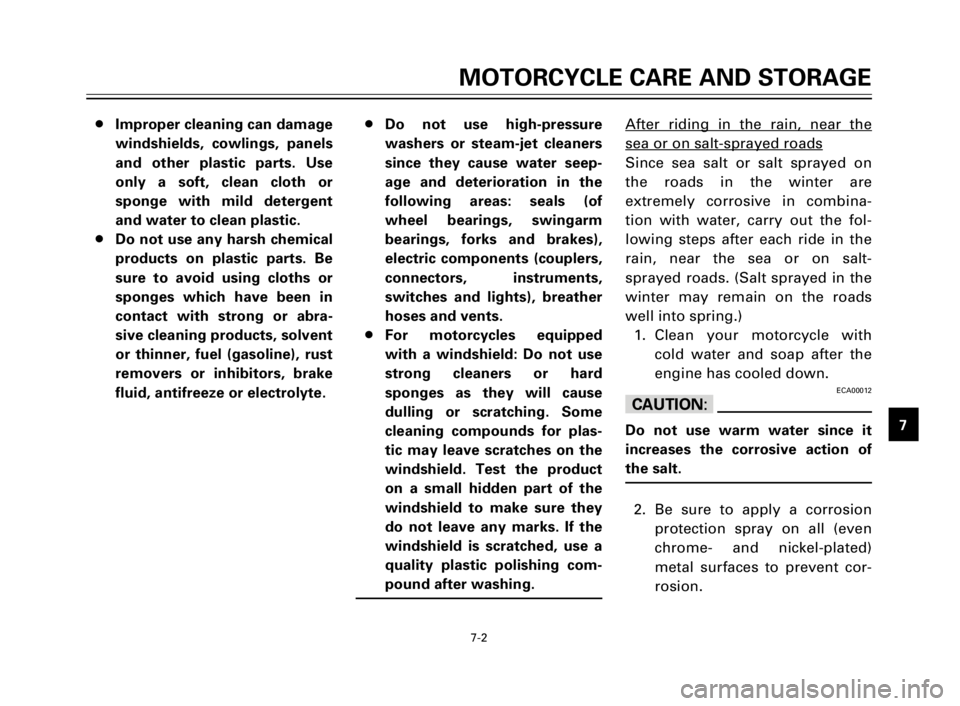
7-2
MOTORCYCLE CARE AND STORAGE
1
2
3
4
5
6
7
8
9 8Improper cleaning can damage
windshields, cowlings, panels
and other plastic parts. Use
only a soft, clean cloth or
sponge with mild detergent
and water to clean plastic.
8Do not use any harsh chemical
products on plastic parts. Be
sure to avoid using cloths or
sponges which have been in
contact with strong or abra-
sive cleaning products, solvent
or thinner, fuel (gasoline), rust
removers or inhibitors, brake
fluid, antifreeze or electrolyte.8Do not use high-pressure
washers or steam-jet cleaners
since they cause water seep-
age and deterioration in the
following areas: seals (of
wheel bearings, swingarm
bearings, forks and brakes),
electric components (couplers,
connectors, instruments,
switches and lights), breather
hoses and vents.
8For motorcycles equipped
with a windshield: Do not use
strong cleaners or hard
sponges as they will cause
dulling or scratching. Some
cleaning compounds for plas-
tic may leave scratches on the
windshield. Test the product
on a small hidden part of the
windshield to make sure they
do not leave any marks. If the
windshield is scratched, use a
quality plastic polishing com-
pound after washing.
After riding in the rain, near the
sea or on salt-sprayed roads
Since sea salt or salt sprayed on
the roads in the winter are
extremely corrosive in combina-
tion with water, carry out the fol-
lowing steps after each ride in the
rain, near the sea or on salt-
sprayed roads. (Salt sprayed in the
winter may remain on the roads
well into spring.)
1. Clean your motorcycle with
cold water and soap after the
engine has cooled down.
ECA00012
cC
Do not use warm water since it
increases the corrosive action of
the salt.
2. Be sure to apply a corrosion
protection spray on all (even
chrome- and nickel-plated)
metal surfaces to prevent cor-
rosion.
5EK-9-E1 (TW125)<3.1> 4/6/0 11:50 PM Page 71
Page 74 of 86
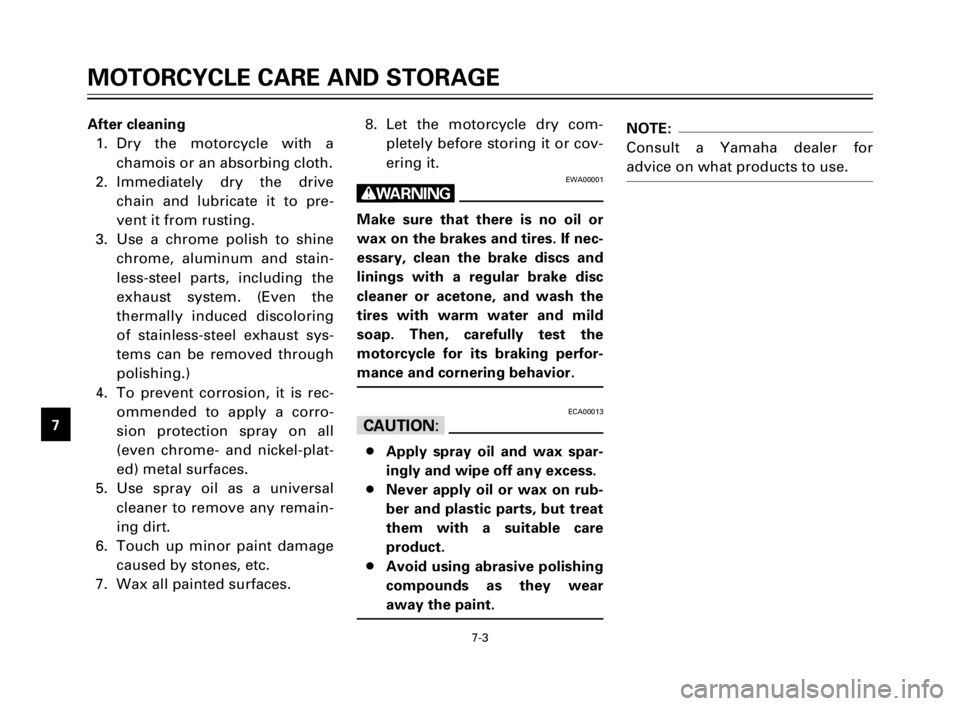
7-3
MOTORCYCLE CARE AND STORAGE
1
2
3
4
5
6
7
8
9After cleaning
1. Dry the motorcycle with a
chamois or an absorbing cloth.
2. Immediately dry the drive
chain and lubricate it to pre-
vent it from rusting.
3. Use a chrome polish to shine
chrome, aluminum and stain-
less-steel parts, including the
exhaust system. (Even the
thermally induced discoloring
of stainless-steel exhaust sys-
tems can be removed through
polishing.)
4. To prevent corrosion, it is rec-
ommended to apply a corro-
sion protection spray on all
(even chrome- and nickel-plat-
ed) metal surfaces.
5. Use spray oil as a universal
cleaner to remove any remain-
ing dirt.
6. Touch up minor paint damage
caused by stones, etc.
7. Wax all painted surfaces.8. Let the motorcycle dry com-
pletely before storing it or cov-
ering it.
EWA00001
w
Make sure that there is no oil or
wax on the brakes and tires. If nec-
essary, clean the brake discs and
linings with a regular brake disc
cleaner or acetone, and wash the
tires with warm water and mild
soap. Then, carefully test the
motorcycle for its braking perfor-
mance and cornering behavior.
ECA00013
cC
8Apply spray oil and wax spar-
ingly and wipe off any excess.
8Never apply oil or wax on rub-
ber and plastic parts, but treat
them with a suitable care
product.
8Avoid using abrasive polishing
compounds as they wear
away the paint.
NOTE:
Consult a Yamaha dealer for
advice on what products to use.
5EK-9-E1 (TW125)<3.1> 4/6/0 11:50 PM Page 72
Page 79 of 86
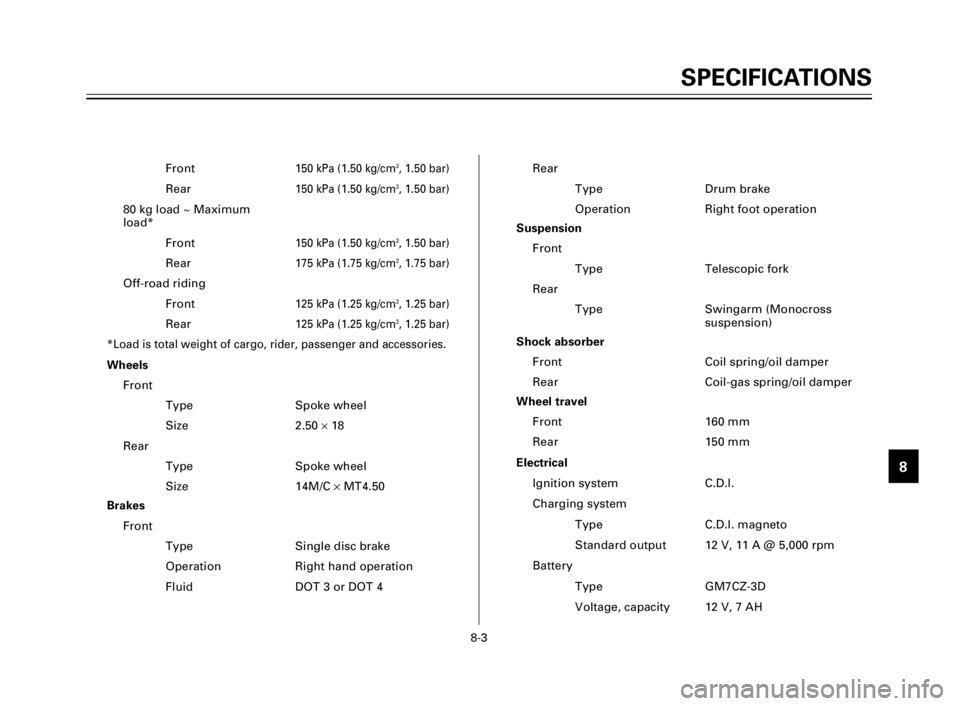
8-3
SPECIFICATIONS
1
2
3
4
5
6
7
8
9
Front150 kPa (1.50 kg/cm2, 1.50 bar)
Rear150 kPa (1.50 kg/cm2, 1.50 bar)
80 kg load ~ Maximum
load*
Front
150 kPa (1.50 kg/cm2, 1.50 bar)
Rear175 kPa (1.75 kg/cm2, 1.75 bar)
Off-road riding
Front
125 kPa (1.25 kg/cm2, 1.25 bar)
Rear125 kPa (1.25 kg/cm2, 1.25 bar)
*Load is total weight of cargo, rider, passenger and accessories.
Wheels
Front
Type Spoke wheel
Size 2.50 ´18
Rear
Type Spoke wheel
Size 14M/C ´MT4.50
Brakes
Front
Type Single disc brake
Operation Right hand operation
Fluid DOT 3 or DOT 4Rear
Type Drum brake
Operation Right foot operation
Suspension
Front
Type Telescopic fork
Rear
Type Swingarm (Monocross
suspension)
Shock absorber
Front Coil spring/oil damper
Rear Coil-gas spring/oil damper
Wheel travel
Front 160 mm
Rear 150 mm
Electrical
Ignition system C.D.I.
Charging system
Type C.D.I. magneto
Standard output 12 V, 11 A @ 5,000 rpm
Battery
Type GM7CZ-3D
Voltage, capacity 12 V, 7 AH
5EK-9-E1 (TW125)<3.1> 4/6/0 11:50 PM Page 77